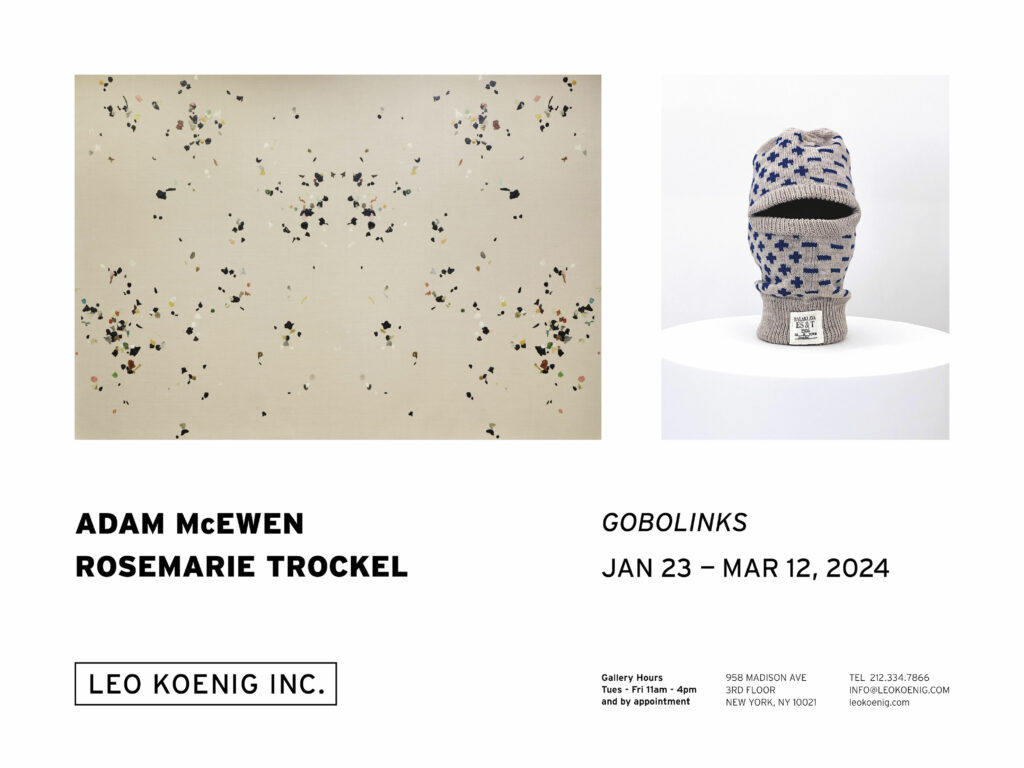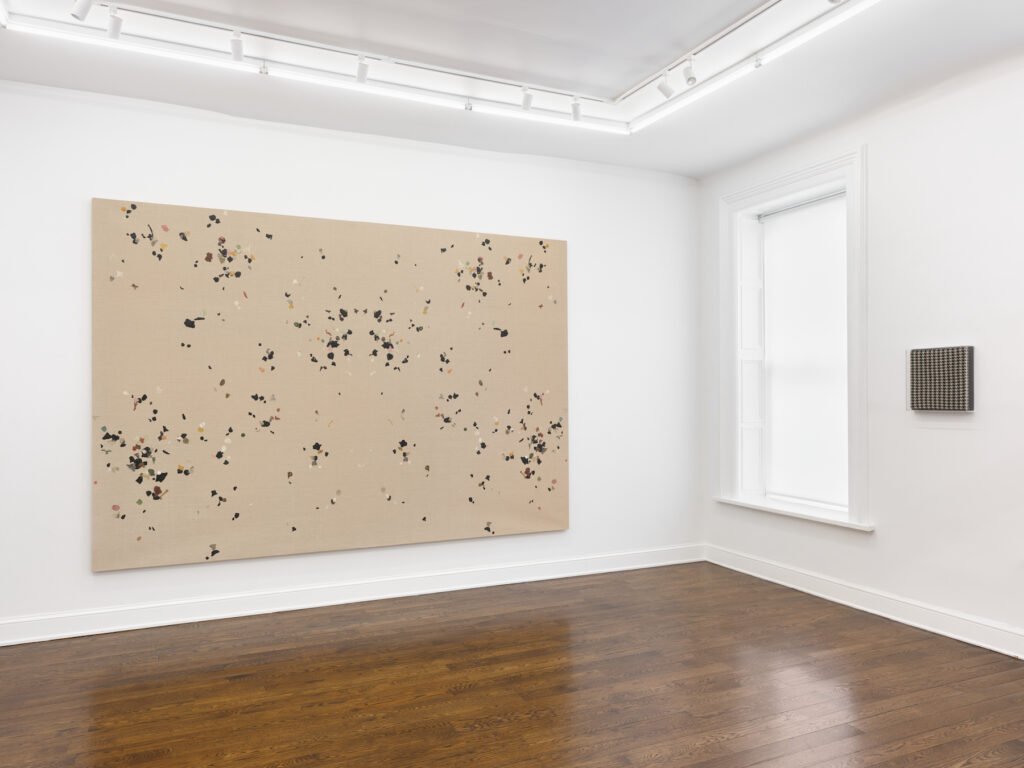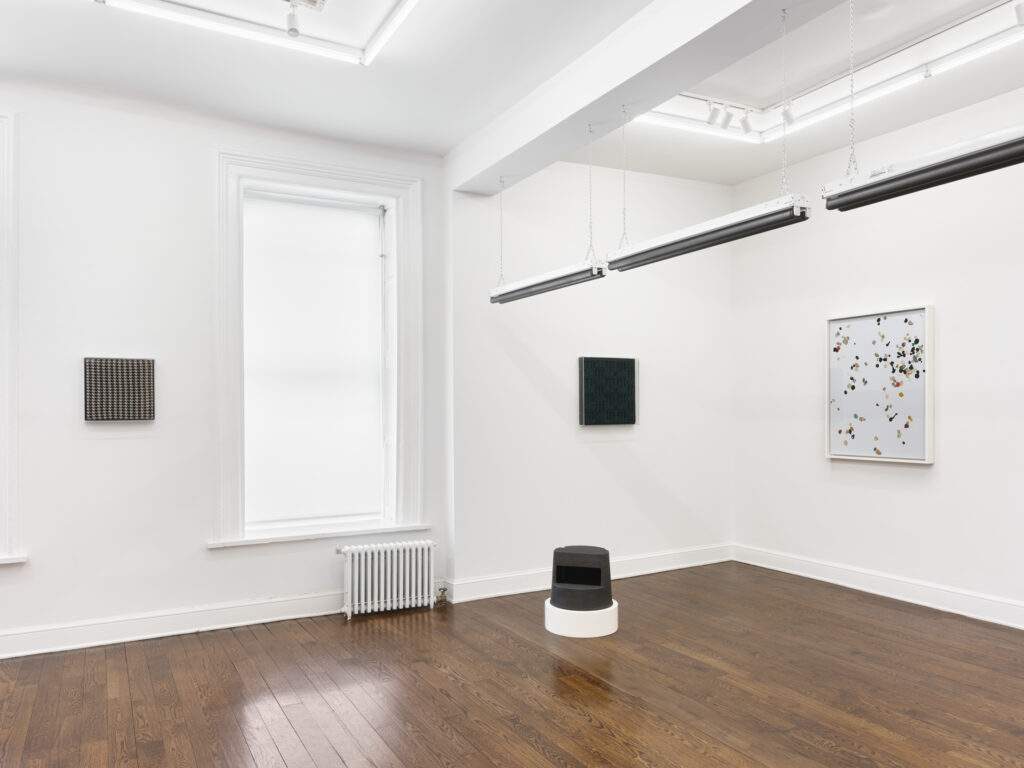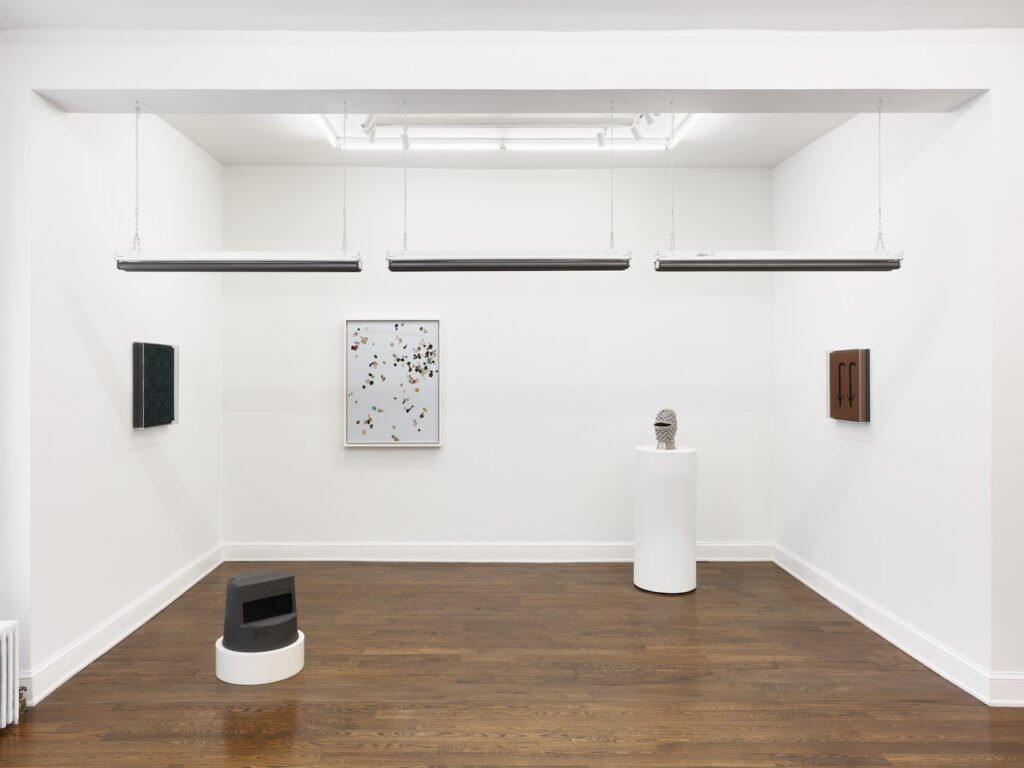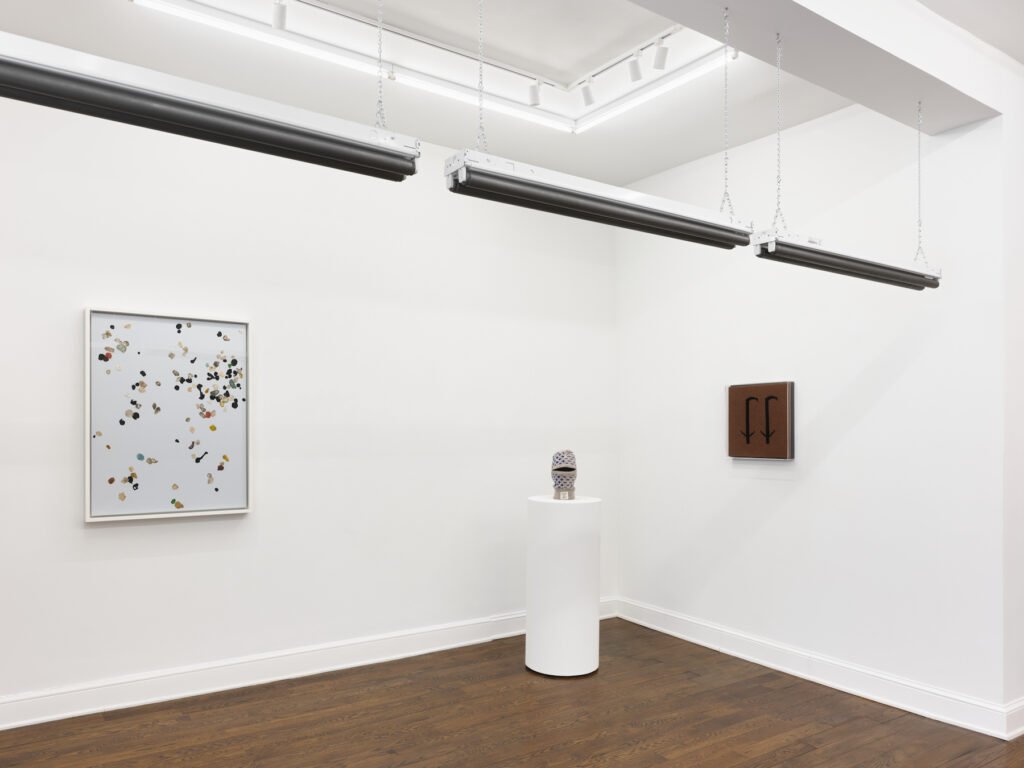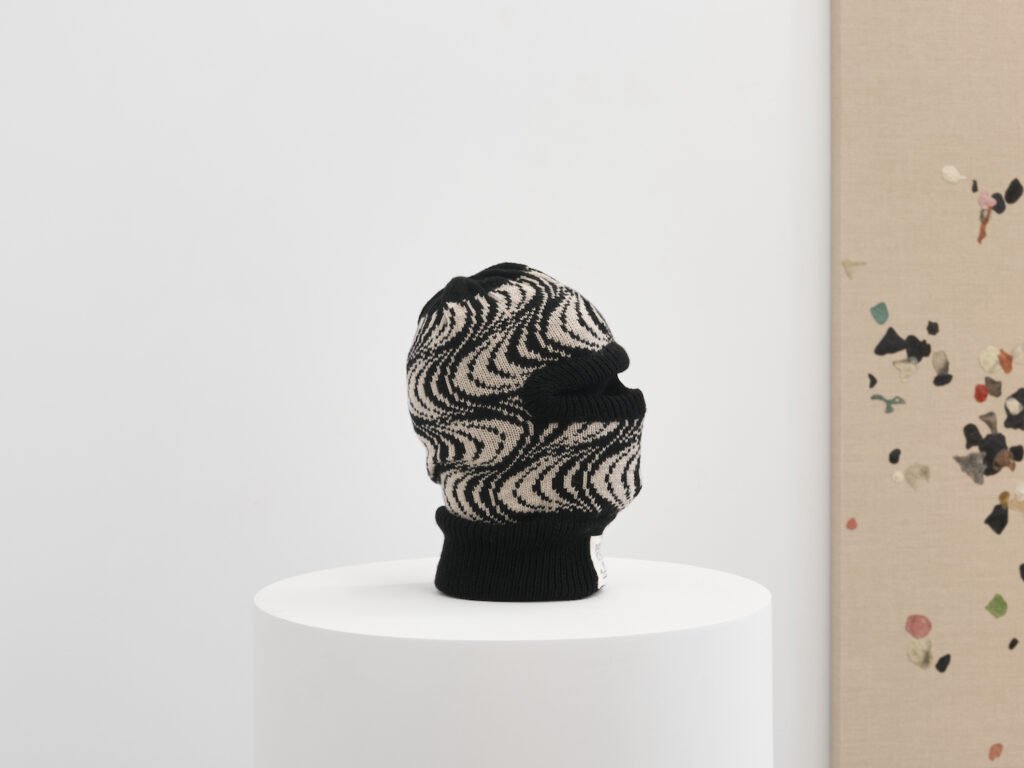Press Release
Gobolinks
January 24 through March 12th
Leo Koenig Inc. Is delighted to announce the opening of Gobolinks, with works by Adam McEwen and Rosemarie Trockel. A Victorian era publication by Ruth McEnery Stuart and Albert Bigelow Paine, Gobolinks or “Shadow Pictures” was a bound book of inkblots that inspired a poem on each page. A Pre-cursor (and arguably an influence) to Rorschach tests, the book’s intent was formost entertainment, and amusement rather than insight into the sub conscience of those playing along.
Adam McEwens’s varied oeuvre similarly delights in this sense of play, imbued with a hint of the Macabre. In the beginning of McEwens’ career, he wrote obituaries for the Daily Telegraph in London, and later used this experience to create works that appeared as obituaries for still living artists and politicians, as they might have been read in newspapers from around the world. In this exhibition, Adam McEwen’s paintings are where we see the most obvious of the “links.” The large raw canvas has various colors of chewing gum and acrylic paint placed in a symmetrical pattern on either side. Though initially the paintings may be perceived as playful, McEwen’s chewing gum painting series allude to the Allied bombings of various towns in Germany during WWII. With that in mind, the splattering and flattening of the gum on the surface of the canvas invokes a completely different, somber connotation, shifting ones focus from immediate childhood pleasures to that of an endless cycle of consumption and destruction, equally repeated. In his Graphite works, we see ordinary objects such as an industrial step stool and a fluorescent light fixture. McEwen first sees these sculptures as “sketches” carved out of the very material that one might use to make a sketch. But these sculptures seem the product of an alternate universe where shiny new things are turned into light-absorbing doppelgangers. This is especially evident in the fluorescent light fixture, whose tubing made of graphite, literally sucks light out of the room.
In Rosemary Trockel’s Strickblider works on view, it is the patterning that toys with interpretation. The works highlight designs taken from existing pattern books and women’s magazines, as well as iconic political and commercial motifs including the hammer and sickle. Begun in 1984, the Strickbilder ‘knitting pictures’ are just one aspect of Trockel’s practice which includes drawings, sculptures and mixed-media installations. Elevating this series from traditional craft, Trockel made blueprints for her designs and had them produced by a technician. Playing the seriousness of political symbolism against the frivolity of fashion patterning brings one to an absurdist juxtaposition of thought. Further choosing wool, a soft material associated with warmth and protection, and knitting, a material and technique traditionally associated with the female domestic realm and craft, Trockel challenges the connotations of materials and skills’ as well as undermining the fraught proclamations of political symbolism. Trockel’s Balaclavas court various interpretations, dependent upon the viewer’s perspective. The familiar piece of clothing can represent leisurely activities such as skiing and mountain climbing, protecting one against the elements. Conversely, the Balaclava can also be perceived as ominous, as it is often used by those with criminal intent. or people simply wishing to evade recognition. Here again, patterning becomes the outlier, and the infusion of whimsical plus minus signs for example,muddles the fact that these articles of clothing can represent a threat. The simple knitted piece projects the weight of fortification or intimidation, warmth or anonymity while the patterning illuminates a sense of levity.
Rosemarie Trockel is a contemporary German Conceptual artist whose work challenges traditional notions of femininity, culture, and artistic production. Employing a wide range of materials, including video, ceramics, drawing, found artifacts, and knitted works, the artist raises questions of politics, domesticity, eroticism, and fantasy. “The minute something works, it ceases to be interesting,” she said of making art. “As soon as you have spelled something out, you should set it aside.” Born in Schwerte, Germany on November 13, 1952, she studied at the Werkkunstschule in Cologne, before going on to become one the first artists to show at Monika Sprüth gallery. Trockel first rose to prominence after exhibiting her celebrated Knitted Paintings (1985) series, which were created using machine-knitted fabrics stretched onto canvas supports. Throughout these woolen surfaces, Trockel depicts generic, computer-generated imagery or, in some cases, specific historic iconography, such as the Soviet worker with a sickle and hammer. In 2012, her sprawling exhibition “Rosemarie Trockel: A Cosmos,” opened at the New Museum in New York, later traveling to the Serpentine Gallery in London the following year. The artist currently lives and works in Cologne, Germany. Today, her works are held in the collections of the Art Institute of Chicago, The Museum of Modern Art in New York, the Tate Gallery in London, and the Kunstmuseum Basel, among others.
Adam McEwen was born in 1965 in London, England. He received his B.A. in 1987 from Christ Church, Oxford, and then received his B.F.A. in 1991 from California Institute of the Arts, Valencia. McEwen’s work has been shown in major exhibitions around the world, including “Axis of Praxis,” Midway Contemporary Art, Minneapolis (2006); “Into Me/Out of Me,” P.S.1 Contemporary Art Center, New York (2006); “Beg, Borrow and Steal,” Rubell Family Collection, Miami (2009); “The Reach of Realism,” Museum of Contemporary Art, North Miami (2009); “Haunted: Contemporary Photography/Video/Performance,” Solomon R. Guggenheim Museum, New York (2010, traveled to Guggenheim Bilbao, Spain); “The Last Newspaper,” New Museum of Contemporary Art, New York (2010); “America Is Hard to See,” Whitney Museum of American Art, New York (2015); and “Progressive Praxis,” de la Cruz Collection Contemporary Art Space, Miami (2016). McEwen’s work was included in the 2006 Whitney Biennial. Recent solo exhibitions include The McAllister Institute, New York (2003); The Goss Michael Foundation, Dallas (2012); The Modern Institute, Glasgow (2013); Museo Civico Diocesano di Santa Maria dei Servi, Città della Piene (2015); “Tinnitus,” The Modern Institute, Glasgow (2016); and “Adam McEwen: I Think I’m in Love,” Aspen Art Museum, Colorado (2017). McEwen currently lives and works in New York City and is represented by Gagosian Gallery.
Gallery Hours are Tuesday, Wednesday, Thursday 11-4 pm and by appointment Please contact the gallery for more information or email us at info@leokoenig.com
